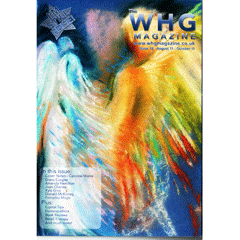
When you walk a labyrinth you’re participating in a 4,000 year old ritual that has spread across the globe from the Mediterranean and found resonance in many world religions and magical traditions. Labyrinths are becoming known for their healing and calming qualities, but less well known is their possible cosmic origins and the power behind them.
Anna Sofar, an American artist, in 1977 was looking for rock art in New Mexico’s Chaco Canyon, believed to have been in use for a thousand years as a religious centre for the surrounding population. She noticed sunlight falling through the stones onto the wall of the ledge behind her. On the wall was engraved a spiral, and the shaft of light cut right through its centre. By chance, it was noon on Midsummer Day; the spiral was placed exactly to mark this alignment. Similarly, at noon on Winter Solstice the spiral was found to be neatly framed by two shafts of sunlight. (1)
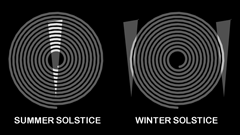
We meet a similar precision of skill and astronomical knowledge closer to home, at the neolithic chambered mound Newgrange, Ireland, where at dawn at the Winter Solstice, pencil-thin sunrays penetrate the passageway into the central chamber, onto the beautiful trispiral carved onto stone C10 (laid out in walkable form at my earlier workshops at Tir-na-nOg and Lendrick Lodge).
So far, we’ve described two pretty impressive sundials. But what of the patterns, that sunlight was so carefully engineered to caress?
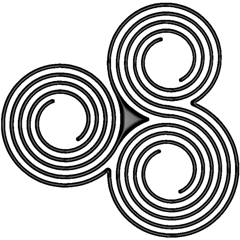
The sun’s motion as seen by ourselves, is to arc from east to west; a small loop when it is lowest at winter solstice, medium sized at the equinox, the largest arc forming at summer solstice. We of course have grown up with a heliocentric worldview. We ‘get’ what is happening to the sun (illustration, left). But how did earlier times view it?
Martin Brennan in The Stones of Time observes, ‘The sun’s reappearance on the horizon suggests that its path forms circles. In order to account for movement from a smaller circle to a larger circle a spiral motion is required,’ (illustration, right). Indeed, he argues that Irish megalithic spiral carvings represent the sun’s rotation and power. (2)
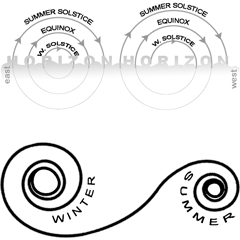
Brennan also describes an experiment by artist Charles Ross, who placed a magnifying glass to chart the sun’s progress by burning marks into planks arranged around it; when graphed, the burn marks showed a double spiral.
This experiment is remarkable because this solar-charting double spiral, in its ‘square’ form, is the double meander ‘zip file’ for the commonest labyrinth historically across the world. Were such labyrinths derived from astronomical observations, to perhaps permit our eyes, fingers or whole bodies physically walk and align themselves with greater bodies in the skies?
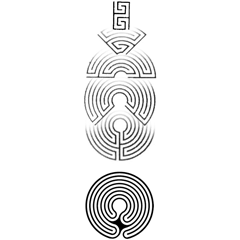
Certainly, it’s easy to feel the energies you can conjure up in a labyrinth. A labyrinth is simply a spiral with an axis placed over it to apply conditions of movement, and in my workshops we explore the rich energy you can tap into by using labyrinths, to affect change in your life and amplify the healing you send to yourself and those dear to you. Where this energy comes from, is up for grabs. Perhaps these cosmic observations are a clue.
We can never conclude that our reading of stones and skies, is applicable to the minds of earlier civilisations. They lived in a profoundly different world to ours. (Witness how complicated it is, for most us now to even see the stars at night.)
And yet, are we so removed? We, like them, want to fill our lives with love, comfort and happiness; and if we seek to engineer the ‘big ones’ in our skies, the sun-jobs and moon-desires and planet-partners circling our spheres, I think those older minds would nod and understand. :-)
Works Cited:
- Brennan, Martin. The Stones of Time: Calendars, Sundials and Stone Chambers of Ancient Ireland. Inner Traditions. 2007.
- Devereux, Paul. The Illustrated Encyclopedia of Ancient Earth Mysteries. Cassell. 2000.
Footnotes:
- Illustration and account adapted from Devereux, p. 38.
- Pictures after Brennan, p. 188, 190.

